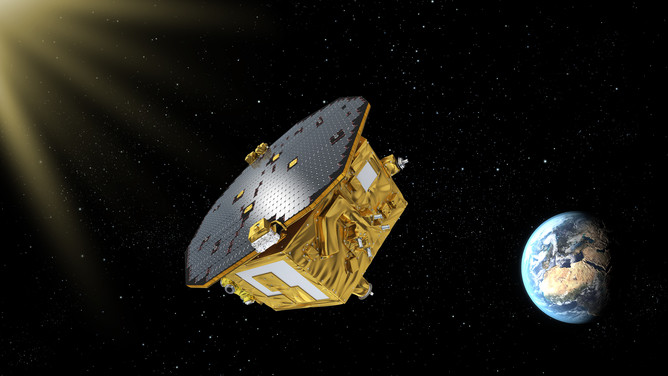LISA Pathfinder will pave the way for us to 'see' black holes for the first time

Harry Ward, University of Glasgow
It has been a century since Einstein presented his theory of general relativity but it is still helping us unveil some of the deepest mysteries of the universe. Now the LISA pathfinder mission will prepare the way for us to study violent events that we've never seen before – such as the creation of massive black holes.
The probe is to test technology needed to launch another mission, eLISA, in 2034, which will aim to detect ripples in space known as gravitational waves. Intriguingly, the project may also help us prove some of the most extreme aspects of Einstein's theory of general relativity.
Chasing waves
General relativity states that gravity is just a manifestation of the fact that mass causes the surrounding space to curve, and it is the curvature of space that dictates the path followed by any other object, or indeed by light. When the Earth goes around the sun, it is the huge mass of the sun that distorts the space around it, leaving the much less massive Earth just following as "straight" a path as it can, but in a curved space: the net effect is the orbit that we are familiar with.
Einstein showed that if something happens to the distribution of mass that is causing a region of space to curve, the changes in curvature will propagate at a finite speed – which we now know to be the speed of light. These propagating ripples in the curvature of space are what we call gravitational waves.
Gravity is the force that orchestrates the universe, but until now we have only been able to observe some of its most superficial effects. However, the ability to directly detect and study gravitational waves would open a completely new window on the universe.
Author's impression of black holes merging.
NASA/wikimedia
Gravitational wave observations would allow us to see intimate details of the creation of massive black holes; supermassive black holes spiralling together and merging as galaxies collide; and neutron stars and black holes orbiting in various pairings until they inevitably spiral inwards and merge.
Seeing directly to the heart of such events will never be possible using normal telescopes that measure electromagnetic radiation. This is because the excited matter typically surrounding such events would obscure our electromagnetic view. Also, black holes, which we have never observed directly, emit virtually no electromagnetic radiation. But Einstein predicted that they do emit gravitational waves if they are accelerating – as they would if in an orbiting system – which is why a gravitational wave detector could "see" them for the first time.
Big challenge – bigger returns
The effect of a passing gravitational wave is quite simple: a wave should stretch space in one direction and shrink it in the direction that is at right angles. Gravitational wave detectors known as laser interferometers, which already exist on Earth, therefore work by splitting a laser beam in two perpendicular directions and sending them down long vacuum tubes. The two paths are then reflected back by mirrors to the point they started, where a detector is placed. If the waves are disturbed by gravitational waves on their way, the recombined beams would show changes in their overall brightness.
But to we need to go into space to catch the richest and most numerous gravitational wave signals. eLISA will be the first space-borne gravitational wave observatory.
eLISA will comprise three satellites in a triangular arrangement with arms of some millions of kilometres. Precision arm length measurements will be made between "test masses" in each spacecraft – freely-floating mirrors that reflect the measuring laser beams that will travel along the long arms.
eLISA is a complex mission. But the scientific return would be enormous. However the first step is to make certain that the required sensitivity is achievable. To demonstrate this, the LISA Pathfinder mission will fly the test masses and the length measurement system of an arm of eLISA, compressed into a single compact spacecraft. These test masses will, ideally, move completely unperturbed by any disturbances. A laser interferometer will monitor the separation between them to establish that there are no unacceptable tiny stray forces acting.
I led the UK team that has laboured long and hard to develop the laser metrology system for Pathfinder. To us, the launch will be the defining moment that signals the exciting beginning of gravitational wave astronomy in space.
Harry Ward, Reader in Physics and Astronomy, University of Glasgow
This article was originally published on The Conversation. Read the original article.
© Copyright IBTimes 2025. All rights reserved.






















